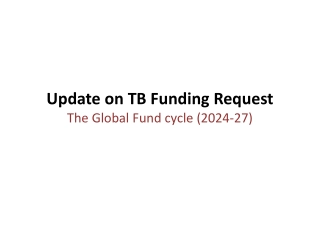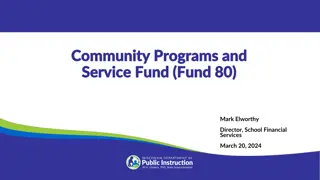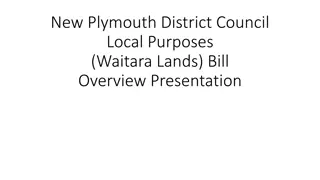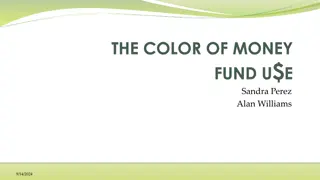Key Changes in Global Fund's Grant Cycle 7 (GC7) for 2023-2025 Allocation Cycle
New Programme Essentials introduced in GC7 focus on critical interventions to achieve global targets on HIV, TB, and Malaria, emphasizing human rights, gender equality, and community responses. The essentials cover areas such as HIV prevention, testing, treatment, and care, including key elements like availability of condoms, Pre-Exposure Prophylaxis (PrEP), post-exposure prophylaxis, harm reduction services, and more. These changes aim to guide country prioritization and support national programs funded by the Global Fund.
Download Presentation

Please find below an Image/Link to download the presentation.
The content on the website is provided AS IS for your information and personal use only. It may not be sold, licensed, or shared on other websites without obtaining consent from the author. Download presentation by click this link. If you encounter any issues during the download, it is possible that the publisher has removed the file from their server.
E N D
Presentation Transcript
What is new in the Global Funds Grant Cycle 7 (GC7)? Preparing for the 2023-2025 Allocation Cycle
I. Key changes in the Global Fund s latest grant cycle (GC7) II. Strategic opportunities to engage in key areas relating to HIV, health systems and community leadership CONTENTS III. Minimum expectations for community engagement IV. Focus on gender equality V. Timeline
I. Key changes in GC7 the Global Fund s latest grant cycle A. Programme essentials
New Programme Essentials have been introduced in GC7 to describe what elements are expected to be included in national programs supported by the Global Fund. Programme essentials help guide country prioritisation The Programme Essentials are critical interventions that are needed to achieve global targets on HIV, TB and Malaria. They have a strong focus on human rights and gender and community responses.
Programme essentials - HIV * New elements are highlighted in red Condoms and lubricants are available for all people at increased risk of HIV infection Pre-exposure prophylaxis (PrEP) is available to all people at increased risk of HIV infection, and post-exposure prophylaxis (PEP) is available for those eligible. Harm reduction services are available for people who use drugs. Voluntary medical male circumcision (VMMC) is available for adolescent boys (15+ years) and men in high HIV incidence settings 1. HIV primary prevention HIV testing services include HIV self-testing, safe ethical partner and social network-based testing A three-test algorithm is followed for rapid diagnostic test-based diagnosis of HIV Rapid diagnostic tests are conducted by trained and supervised lay providers in addition to health professionals 2. HIV testing & diagnosis 3. Elimination of vertical transmission Antiretroviral treatment (ART) is available for pregnant and breastfeeding women living with HIV to ensure viral suppression HIV testing, including early infant diagnosis (EID) is available for all HIV-exposed infants Rapid ART initiation follows a confirmed HIV diagnosis for all people irrespective of age, sex or gender. HIV treatment uses WHO recommended regimens. Management of advanced HIV disease is available. Support is available to retain people across the treatment cascade including return to care. CD4 and viral load testing, and diagnosis of common comorbidity and co-infections are available for management of HIV 4. HIV treatment & care
Programme essentials cont. - HIV * New elements are highlighted in red 5. TB/HIV People living with HIV with active tuberculosis (TB) are started on ART early TB preventive therapy is available for all eligible people living with HIV including children and adolescents HIV services (prevention, testing, treatment and care) are available in health facilities, including sexual and reproductive health services, and outside health facilities including through community, outreach, pharmacy and digital platforms. Multi-month dispensing is available for ART and other HIV commodities 6. Differentiated service delivery (DSD) HIV programs for key and vulnerable populations integrate interventions to reduce human rights- and gender-related barriers. Stigma and discrimination reduction activities for people living with HIV and key populations are undertaken in health care and other settings. Legal literacy and access to justice activities are accessible to people living with HIV and key populations. Support is provided to efforts, including community-led efforts, to analyse and reform criminal and other harmful laws, policies and practices that hinder effective HIV responses 7 .Human Rights
I. Key changes in GC7 the Global Fund s latest grant cycle A. Programme essentials B. Information Notes
Available for download on the Global Fund website Information Notes on HIV, TB, Malaria and Resilient and Sustainable Systems for Health (RSSH) have been published Click to download!
I. Key changes in GC7 the Global Fund s latest grant cycle A. Programme essentials B. Information Notes C. Modular Framework
The Framework focuses on 4 key areas The Global Fund have written a Modular Framework Handbook it includes standard modules, interventions and performance indicators to support the development of funding request to the Global Fund. It can be found at: HIV TB The Modular Framework Malaria Resilient and Sustainable Systems for Health https://www.theglobalfund.org/media/ 4309/fundingmodel_modularframewor k_handbook_en.pdf
Overview of modules and interventions on HIV Elimination of vertical transmission of HIV, syphilis and hepatitis B Prevention Treatment, care and support Differentiated HIV Testing Services HIV treatment and differentiated service delivery - Adults (15 and above) - Children (under 15) Testing of pregnant women for HIV, HBV, syphilis One testing module that includes a combination of service delivery modalities and programs, namely For PUD (injecting and non- injecting) Needle and Syringe programs, incl. HBV and HCV Opioid substitution therapy and other medically assisted drug dependence treatment Overdose prevention and management Condom and lubricant programing Pre-exposure prophylaxis programming HIV prevention communication: information and demand creation Sexual and reproductive health services, including STIs, HBV, post-violence care Harm reduction Community empowerment Removing human rights- related barriers to prevention HIV prevention for HIV negative pregnant and breastfeeding women Treatment monitoring - Drug resistance Facility testing Community testing Self-testing Post-natal infant prophylaxis Treatment monitoring - Viral load and ARV toxicity Early infant diagnosis and follow-up HIV testing for exposed infants In programs Integrated management of common co-infections co-morbidities (adults and children) KPs programs (not disaggregated) AGYW programs Non KPs/Non AGYW programs Specific to AGYW & MSP in high incidence settings Social protection interventions CSE for AGYW and ABYM Voluntary Medical Male Circumcision Retention support for pregnant and breastfeeding women (facility and community) Diagnosis and management of advanced disease (adults and children) TB/HIV collaborative activities Screening, testing and diagnosis Treatment Prevention Community TB/HIV care delivery TB Key populations TB/HIV Cross-cutting Modules 11 (i.e. RSSH, Program Management, Reducing Human right related barriers to HIV/TB services)
RSSH Modules and interventions Modules Interventions RSSH: Health sector planning and governance for integrated people- centered services Health sector planning and governance for integrated people centered services Integration/coordination across disease programs and at service delivery level Supporting private sector engagement RSSH: Community systems strengthening Community-led monitoring Community-led research and advocacy Community engagement, linkages and coordination Capacity building and leadership development RSSH: Health Financing Systems Health financing strategies and planning Public financial management systems Routine financial management systems Community led advocacy and monitoring of domestic resource mobilization Social Contracting Health financing data and analytics Blended Financing Arrangements RSSH: Health Products Management Systems Policy, strategy, governance Storage and distribution capacity, design & operations Planning and procurement capacity Regulatory/quality assurance support Avoidance, reduction and management of health care waste Supply chain information systems Augmenting national supply chain system with outsourcing
RSSH Modules and interventions Modules Interventions RSSH/PP: Human resources for health and quality of care HRH planning, management and governance including for community health workers (CHWs) Education and production of new health workers (excluding CHWs) Remuneration & deployment of existing/new staff (excluding CHWs) In-service training (excluding CHWs) Integrated supportive supervision for health workers (excluding CHWs) Quality improvement and capacity building for quality of care Community health workers: selection, pre-service training and certification Community health workers: contracting, remuneration and retention Community health workers: In-service training Community health workers: Integrated supportive supervision RSSH/PP: Laboratory systems National laboratory governance and management structures Quality management systems and accreditation Laboratory Information systems Network optimization and geospatial analysis Laboratory based surveillance Laboratory supply chain systems Specimen referral and transport system Biosafety and biosecurity, infrastructure and equipment management
II. Strategic opportunities to engage in key areas relating to: A. HIV B. Health Systems C. Community Leadership
Stronger focus on HIV prevention - differentiated for scale, expanding coverage and improving quality Integration of SRH/STI and HIV services Strengthened platforms for delivery to expand options (PrEP, condoms, DPV rings) AND ways of delivering services (community-led, virtual, pharmacy etc.) Key changes / new emphasis provide opportunities for engagement on HIV Prioritise people living with HIV across their life-course and populations with the highest risk and vulnerability to HIV Greater emphasis on data for decision-making, incl. community participatory needs assessment and community-led monitoring Move away from behavioral interventions to health communication and demand creation Addressing chemsex Click to download! Continued emphasis on community-led, community-based programmes, addressing human rights- and gender-related barriers to services and Community System strengthening
Community-led programming is essential to achieve objectives Integrate community health strategies as part of national disease response Support policy advocacy, reform and innovative sustainability mechanisms to enable community-led groups and networks to provide peer-led services, particularly where key populations face substantial barriers to accessing services and system strengthening Scale and integrate CHW programmes Make interventions more people-centered with explicit emphasis on community-led initiatives, strengthen community engagement, linkages and coordination; capacity building and leadership development More tailored activities including: differentiated capacity building; support for legal registration and safe operations of community-led organisations; emphasis on institutionalising CLM data/feedback for data driven decision making Click to download!
Activities led and implemented by local community-led organisations to improve accessibility, acceptability, affordability, quality and impact of health services. For example: Emphasis on community-led monitoring and data for decision- making Development of national community-led monitoring frameworks and strategies for public health facilities, private facilities and in community-based settings (e.g., observatories, alert systems, scorecards etc.) Community-led monitoring of barriers to accessing services. Piloting new community-led monitoring mechanisms and programs for learning and improvement. Tools and equipment including appropriate technologies for data management and storage. Technical support and training: e.g. development of data collection tools, data cleaning and analysis, using community data to inform decision-making and advocacy, informed consent, ethics approval, etc. Presentation and discussion of community-led monitoring data and recommendations in various governance structures, oversight mechanisms and other decision-making fora. Click to download!
Guidance on service delivery arrangements CLOs/CBOs are well placed to deliver the following services in the HIV-specific programmes: HIV Prevention Delivery of commodities, behavioral interventions, services for KPs, incl. harm reduction and peer-based services, integration of HIV into SRHR services Testing Community-based testing, counselling, peer support (e.g. home testing), linkage Treatment Education/literacy, peer navigation, adherence support, loss-to-follow up Demand creation Awareness raising, demand generation, address gender norms Care and support Psychosocial support, care for families, economic empowerment Rights and legal services Stigma reduction programs, GBV prevention and response, paralegal services, legal and human rights literacy Sensitisation Healthcare personnel, lawmakers, law enforcement officials *Note - other pillars of community responses, incl. activities related to advocacy, participation in accountability, CLMs, participatory community research and community resource mobilisation should all be community-led
III. Minimum expectations for community engagement A. The Global Fund context B. Minimum expectations
The leadership of communities living with and most affected by the three diseases is central to the Global Fund. Communities playing a central role in its governance at country and global levels, as implementors, in accountability, and as advocates for its mission. Community Engagement in the Global Fund context Extensive evidence on the importance of community engagement and the connection between communities engaged in decisions that impact on their lives, trust between communities and other actors in health responses, and the effectiveness of interventions, programs and systems that are responsive to actual and changing needs. The Global Fund s goals and mission outlined in the Global Fund Strategy 2023-2028 commits to: a stronger role and voice for communities living with and affected by the diseases, reinforcing this unique strength of the Global Fund and tackling barriers to effective participation and leadership, to put the most affected communities at the center of everything we do. Click to download!
The minimum expectations for community engagement across the full grant cycle are: 1. Funding Request and Allocation Letter: A transparent and inclusive consultation process with populations most impacted by the three diseases during funding request leading to the development of an Annex of Funding Priorities of Civil Society and Communities Most Affected by HIV, TB and Malaria Minimum Expectations for community engagement 2. Grant Making: Community and civil society representatives on the CCM have timely access to information on status of grant negotiations and changes to the grant to support their involvement in oversight 3. Grant Implementation: Community and civil society representatives on the CCM have timely access to information on program implementation Click to download!
IV. Gender Equality A. The Global Fund strategy
Gender equality - Action from the Global Fund STRENGTHENED funding request requirements: applicants required to demonstrate in greater detail how they have identified gender-related barriers, why they exist, how they impact on health outcomes, and how they are addressed in the funding request NEW gender assessment tools: applicants provided examples of tools to help complete and use gender assessments. Gender assessments will be submitted alongside funding request NEWGender Equality Marker. All funding requests scored against gender-equality criteria relating to program design, implementation and evaluation STRENGTHENED community engagement, including from women and gender- diverse communities, through minimum expectations at three stages across grant lifecycle NEW: two gender-equality KPIs for assurance and accountability NEWmid year evaluation: to assess how GF s actions are translating into gender- responsive programming STRENGTHENED gender risk management: more comprehensive definitions, root causes and capacity assessment tool Funding Request Grant-making Grant implementation RETAINED CCM requirements on representation from women, girls and gender-diverse communities RETAINED: Country support for implementation from CRG technical experts RETAINED gender technical brief: made more user- friendly RETAINED: support uptake and use of community-based monitoring RETAINED: gender equality in TRP assessment criteria RETAINED: KPI on data disaggregation RETAINED: provide/broker quality TA, including through Strategic Initiatives
V. Timeline A. What next?
The next grant cycle runs from 2023 to 2025. Countries are invited to apply for new grants during one of four windows in 2023. Key Dates Countries can choose which window to apply in and additional windows will be added see here for latest information: https://www.theglobalfund.org/en/applying-for-funding/design-and- submit-funding-requests/timing-of-submissions/ Click to download!
Timeline Click to download!
To find out more or for guidance on how to engage with GC7 processes contact: Further Info Saima Jiwan sjiwan@gnpplus.net Click to download!























